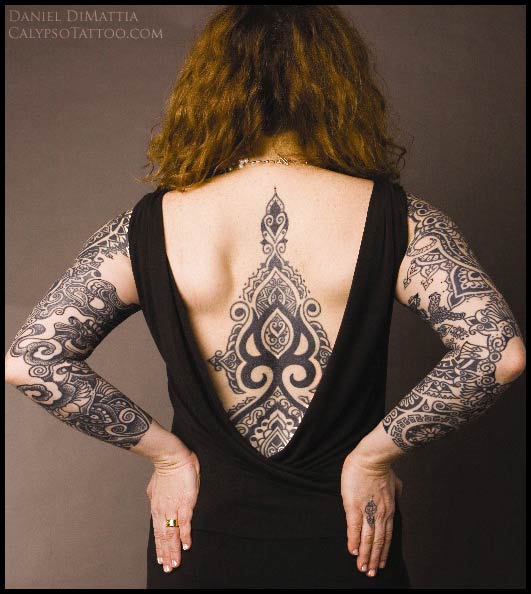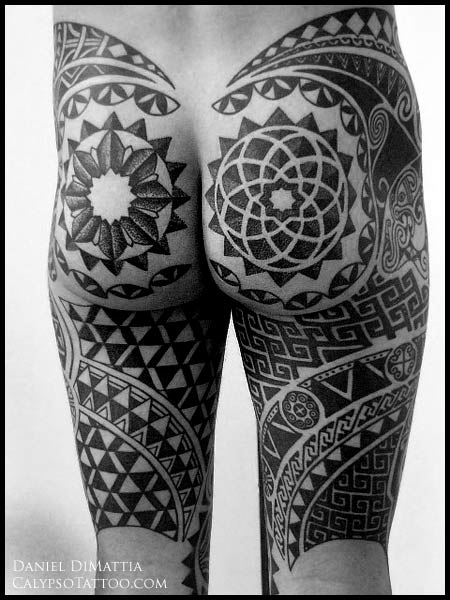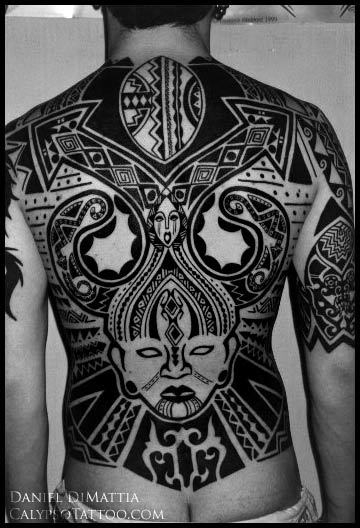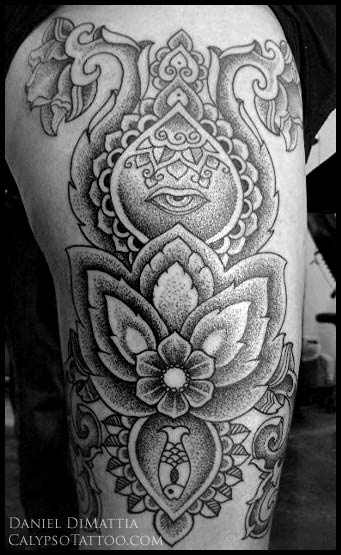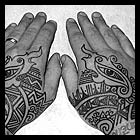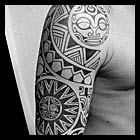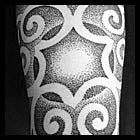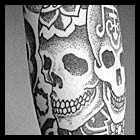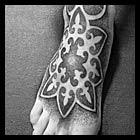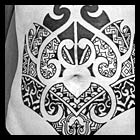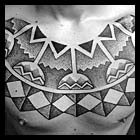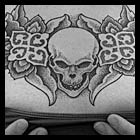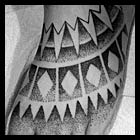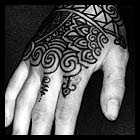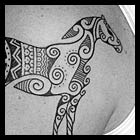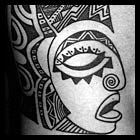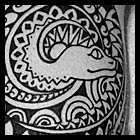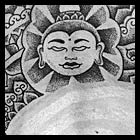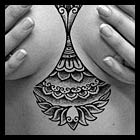|
-Ken Cohen, The Way of Quigong
It’s been my observation that not only do great tattoo artists exude raw artistic talent, but that they are also people of great humor, kindness, and wisdom. I believe that Daniel DiMattia, a master of neo-tribal tattoo art and a decade-and-a-half veteran in the field has all of these traits in abundance. His beautiful blackwork has long been some of my favorite ink posted to BME, and it was a pleasure to finally be able to interview him. You can find Dan at Calypso Tattoo in Belgium. He travels regularly, so visit his website for more photos, contact details, and information on upcoming conventions he’ll be at.
* * * BME: What got you drawing? I’ve been drawing since I can remember — that doesn’t mean I was good — but I was always drawing, like a compulsion. I attended art academy, but only lasted a year and half because I felt I didn’t fit in. I came from the street, I was rough. I wasn’t sensitive and feeling creative vibrations from everything around me like the others. It made me uncomfortable so I left. But I always kept drawing and tried to teach myself. Then I found tattoos and it felt more real, closer to people, still creative but grounded in reality. BME: What kind of exposure did you have to tattoos as you were growing up? When I was young in Belgium, tattoos seemed limited to hand-done scratcher tattoos, usually on those who spent time in jail. So I was attracted to it because I wanted to be cool. At age 14, I took a metal compass and some ink and tattooed a cross on my arm — it was awful and my parents went insane. Fourteen years later while traveling around Europe, I met people with real beautiful tattoos, real works of art, and it inspired me. From then on, I decided I wanted to learn to create art on skin. I was living in Sweden in the eighties and boxing in a club where there were a lot of skinheads. Many of them had fine line, black and grey tattoos. Doc Forest, the Swedish godfather of fine art tattooing in Europe, was creating these illustrative, painterly tattoos. Amazing work. So naturally, I first went to him when I decided I wanted to learn to tattoo. He was nice but didn’t need any help at the time, so I was out of luck. Then I returned to Belgium and couldn’t find any tattooists here to teach me either. But I did find books like Ed Hardy’s Tattoo Time series and the first biker/tattoo magazines and this helped because they also advertised tattoo equipment. One advertisement offered machines, autoclaves, tubes, needles — the whole kit for beginner tattooists. The address was in New York and for me at the time, New York meant NYC, so I went to the States for the first time in my life. I ended up renting a room in Staten Island from another ad in the magazine. It was in a pretty dangerous place. A real experience for this guy from a small city in Belgium. I took the ferry to Manhattan and went around asking people — showing them the ad — where could I find the address? Turns out, it was in upstate NY. Three hours away! I called the place and they said I could have ordered the kit in Belgium with just a credit card. So, I went back, got a credit card and ordered. But before I did that, I tried to find tattooists in NYC. Tattooing was still illegal at the time and everything was underground, so again, no luck! It was an adventure though. As you can see from my story, it was really tough trying to be a tattooist at that time. No eBay for tattoo kits. No Internet for techniques and tips. You had to go out and search for everything yourself. BME: You’re self-taught? I started learning on myself. This is why my legs look so bad! I also started going to conventions like Amsterdam and Dunstable at the time and just watched the artists work. This helped a lot and also increased my desire to do the type of work that I was seeing there. Refining the craft is about practice, pushing yourself to do better but also experimenting — finding better equipment, and trying out new tools and techniques to see what works best. BME: Besides going crazy about the first tattoo you did on yourself, what do your parents think about your career choice now? My parents are Italian immigrants in Belgium. My father worked the mines and my mother worked in a factory, so their lives weren’t easy. Like many immigrants, they wanted security and tattoos didn’t represent that. But once I showed them that tattooing is not only an art but a business they came around — but it took a while. * * *
* * * BME: Tell me about how you actually started tattooing professionally. I started tattooing professionally in 1992. The first one was a snake coming out of an apple — not a very exciting start for the design but for me, everything was exciting just to practice how to do a good line and get that color in. For four years I did all types of tattoos, but I began to specialize in blackwork after more and more people were coming to the shop asking for tribal tattoos. I realized that there was more to blackwork than just traditional tribal patterns. There is more you can do with black ink. Because I am using only one color, I have unlimited uses of forms and design. To experiment with backwork on a large scale, in around 1996, I started tattooing local punks for free but they had to give me their backs and arms to do whatever I wanted. This is really how I started developing my own style. A lot of them came with me to conventions and showed the work I did on them, entered contests, and that’s how my work began appearing in magazines. Conventions helped promote my style of work. Again, at the time, Internet access wasn’t in every home here and there was no vast tattoo media as there is today, so people couldn’t see your work unless you went out there and showed them. BME: What influences you as an artist? I am influenced by any art that is well balanced, has an interesting shape and gives off a strong attitude, which includes many feminine shapes. I am influenced by gothic motifs, African patterns and masks, Asian art — all ornamental designs give me inspiration to create something different every time. I’m also influenced by my clients — some of my favorite works are inspired from the wild imaginations of my clients. BME: How do you usually work with a client to come up with a piece in your style? In general, I ask people who come to me what they are most attracted to out of my portfolio, whether it’s abstract dotwork or more traditional Polynesian or a fusion of ethnic styles. I then create a work that is special to the client. Sometimes I ask questions about the person’s life because I can incorporate design elements and symbols that tell the person’s story. BME: Do you ever turn clients away? I turn people away who are not certain of what they want. A person must be certain that they want to get tattooed. I never want anyone to walk out of my studio with regret. I love my job because it is the opposite — people walk away happy and that positive energy drives me. BME: Does working in black only limit you as an artist? Working in black pushes me as an artist because I don’t have a large pallette of colors to work from so I have to keep researching and finding ways to stay fresh and create different works for different people. While I love old school and Japanese work — and have some on my own body — it would take a lifetime to learn how to do it really well, so I’ll leave that to the others who specialize in it and admire their work. BME: I saw you’re doing more and more dotwork tattoos. There’s been some debate on how well these will age — do you feel they will do better or worse in the long run than “normal” tattoos? Dotwork ages very well. It’s less damaging to the skin, softer, and tends to heal better — all factors affecting longevity. But with any tattoo, it’s about how well you take care of it and your lifestyle. If you’re constantly in the sun, if you gain or lose weight in extremes, do drugs or any other activity that’s bad for the skin and your health in general, it will probably show in the tattoos. So if you lead a healthy lifestyle, you’ll protect your artwork investment. * * *
* * * BME: As a “famous” tattoo artist, have you had any “famous” clients? I had a famous footballer (soccer player) come into the studio once with his entourage thinking that I was going to stop everything to do a little tattoo for him — he didn’t even know what he wanted. These guys are treated like gods here but I could care less. I told him I was busy and to make an appointment — and leave a deposit so I know he’d come back. He couldn’t believe I would even ask such a thing and his crew was saying, “Do you know who this man is?” Kicking a ball around a field for a lot of money will not earn my resepct. Leaving a deposit will. I never saw him again. I’ve actually had a couple of ‘celebrities’ from the U.S. contact me, but I never worked on them because I could [would] not accommodate them the way they wanted. My favorite clients are the ‘average Joe’ as you say in English. Students, soccer moms, engineers, electricians, and a redheaded lawyer on occasion. People who come because they love tattoos. BME: Redheaded lawyers, eh? Ahaha! I found my wife through tattooing! We met at the NYC tattoo convention in 2001 and a couple of months later she was living with me in Belgium. (We married in 2005). We share the same passions and philosophy, which is a foundation for any couple. BME: If you could choose any three tattoo artist to tattoo you, who would they be? Wow. There are so many and so little space on my body! Xed from Into You in London — his compositions and dotwork are inspiring. I like the traditional Polynesian work of Manu and the hand Samoan work by Pili Mo’o, and I love the new color work from people like Nikko, Mike DeVries, and Tim Kern. BME: Quite a few of the tattoo artists I’ve talked to lately have mixed feelings about the massive mainstream popularity of tattoo reality shows like “Miami Ink” — how do you feel about them? I think it’s good and bad. These shows inspire people to get custom work and not just flash off the walls. It shows the process of tattooing and educates the public, which helps remove the negative stereotype about tattoos. But it also creates new stereotypes like a person has to have some great story behind every tattoo, which I don’t believe. BME: Any interest in being on one of those shows? I was offered an opportunity to appear as a guest artist but I never did because I didn’t want to play a part. I’m not an actor. I don’t think a TV appearance would make me a better tattooist. I don’t see how it would enrich my life. * * *
Dotwork Thigh
* * * BME: What do you think the future of tattooing holds? It’s always the same, under the skin! Whether it stays fashionable as it is now or loses its popularity, it will always attract those who feel the compulsion to mark their bodies. I believe it is a genetic drive in some people to mark their skin. This does not follow fashion. BME: I agree completely. How do you feel about tattooing faces and other public skin? I’ve done hands, faces, heads, necks — all public places. I take it very seriously. Decorating the face, to me, relates to the divine, the spirit of the person. It’s more than just decoration, like the hands, which are related to creativity. So in doing the face, the person must have a certain ideology, a philosophy behind the desire. BME: What would you do if you weren’t a tattoo artist? A massage therapist. A QiGong teacher. Something that will make people feel good about their bodies and their spirit. BME: Speaking of massage, have you experienced any physical problems from a decade and a half of tattooing? I did experience a great deal of back pain; that is, until I found T’ai Chi and QiGong. This unblocked my energy in my body and loosened me up so that I’m better able to absorb the tension from tattooing in difficult positions. I recommend it to everyone. It made such a difference in my life and I feel I can go on tattooing for many years to come because of it. BME: I saw a piece in your portfolio where you’d tattooed next to a large scarification piece — how do you feel about the rising popularity of other forms of body modification like this? If a certain body modification speaks to someone like tattooing does for me, then who am I to judge? BME: What are some tips that you would offer to young tattoo artists seeking to better themselves? Don’t be afraid to freehand your drawing on the body. It’s a great exercise in creating a flow and harmony with the body. Also, go to conventions and watch how your favorite artists work. These days, people are more open, so you shouldn’t feel shy to ask questions — but politely of course and at the right moment. I’m pretty free about giving advice to young artists at conventions, except those that scream in my client’s ear about what kind of needles I’m using, or spilling beer on my booth. BME: Have you ever apprenticed anyone? I did apprentice someone once, someone I treated like a son, and in return he showed me disrespect. It was a hurtful experience and I don’t have the desire to apprentice anyone again. Well, maybe for a lot of money when I’m old and have arthritis! * * * A Gallery of Tattoos by Daniel DiMattia * * * BME: Finally, how do people get in touch with you to book an appointment, what’s your typical touring schedule? The best way to get in touch with me is via email — although I always appreciate people’s patience because it can take me a while to answer. Also, English is not my first language so for very detailed emails, my wife helps out and I’m at the mercy of her very busy schedule. My touring schedule varies and this year we’re starting to slow down on the number of conventions we’re doing but there are always staples that I work like the NYC Tattoo Convention May 16-18 and the London Tattoo Convention September 26-28. I’m also excited to be a part of a new convention by Skin Deep Magazine in North Wales coast called the Tattoo Jam, August 1-3.. Especially for conventions, I usually take appointment months in advance, but people can always contact me to see if there are any cancellations. Beyond the NYC Convention, I also come to NY a number of times during the year to work on clients at Tattoo Culture in Williamsburg, Brooklyn. Of course, a lot of people travel to Belgium and we’re happy to help them make arrangements for their “tattoo vacation”.
|
Post navigation
 BME/News and Modblog highlight only a small fraction of what BME has to offer. Take our free tour and subscribe to BME for access to over 3 million body modification related photos, videos, and stories.
BME/News and Modblog highlight only a small fraction of what BME has to offer. Take our free tour and subscribe to BME for access to over 3 million body modification related photos, videos, and stories.

